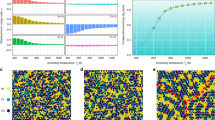Abstract
Non-basal slips are important for ductility and formability of magnesium. Alloying elements can activate the non-basal slip by reducing critical resolved shear stress anisotropy among slip planes, and the optimum alloy contents in binary alloys can be estimated using atomistic simulations. The critical resolved shear stress anisotropy of multicomponent Mg alloys can be minimized if the content of alloying elements is adjusted so that the overall contribution to the dislocation binding intensity from the individual elements is equal to that of the binary alloy with the optimum alloy content. The activation of non-basal slips in multicomponent Mg alloys can be robust when an element with relatively weak dislocation binding is the main alloying element. Grain boundary segregation or solute clustering that can have an effect on the grain boundary mobility, recrystallization, and eventually the texture is another requirement for improved formability. The mechanism for the effect of grain boundary segregation or solute clustering on the texture evolution is discussed, and it is demonstrated that experiments confirm that the multicomponent Mg alloys satisfying the above criterion show higher room temperature tensile elongation and formability than other alloys.
Access this chapter
Tax calculation will be finalised at checkout
Purchases are for personal use only
Similar content being viewed by others
References
Sandlöbes S, Zaefferer S, Schestakow I, Yi S, Gonzalez-Martinez R (2011) On the role of non-basal deformation mechanisms for the ductility of Mg and Mg–Y alloys. Acta Mater. 59:429–439
Agnew SR, Duygulu Ö (2005) Plastic anisotropy and the role of non-basal slip in magnesium alloy AZ31B. Int. J. Plast. 21:1161–1193
Pei Z, Zhu LF, Friák M, Sandlöbes S, Von Pezold J, Sheng HW, Race CP, Zaefferer S, Svendsen B, Raabe D, Neugebauer J (2013) Ab initio and atomistic study of generalized stacking fault energies in Mg and Mg–Y alloys. New J. Phys. 15:043020
Kim K-H, Jeon JB, Kim NJ, Lee B-J (2015) Role of yttrium in activation of <c + a> slip in magnesium: An atomistic approach. Scr. Mater. 108:104–108
Kim K-H, Hwang JH., Jang H-S, Jeon JB, Kim NJ, Lee B-J (2018) Dislocation binding as an origin for the improvement of room temperature ductility in Mg alloys. Mater. Sci. Eng. A. 715:266–275
Lee J-K, Lee B-J (2021) The origin of activation of non-basal slip in Mg-Ce dilute alloy - An atomistic simulation study. Met. Mater. Trans. A. 52A:964–974
Jang H-S, Lee J-K, João Seco Ferreira Tapia A, Kim NJ, Lee B-J (2021) Activation of non-basal c+a slip in multicomponent Mg alloys. J. Magnesium and Alloys, in press
Hantzsche K, Bohlen J, Wendt J, Kainer KU, Yi SB, Letzig D (2010) Effect of rare earth additions on microstructure and texture development of magnesium alloy sheets. Scr. Mater. 63:725–730.
Al-Samman T, Li X (2011) Sheet texture modification in magnesium-based alloys by selective rare earth alloying. Mater. Sci. Eng. A. 528:3809–3822.
Lee JY, Yun YS, Kim WT, Kim DH (2014) Twinning and texture evolution in binary Mg-Ca and Mg-Zn alloys. Met. Mater. Int. 20:885–891
Mishra RK, Gupta AK, Rao PR, Sachdev AK, Kumar AM, Luo AA (2008) Influence of cerium on the texture and ductility of magnesium extrusions. Scr. Mater. 59:562–565
Chino Y, Kado M, Mabuchi M (2008) Enhancement of tensile ductility and stretch formability of magnesium by addition of 0.2 wt%(0.035 at%)Ce. Mater. Sci. Eng. A. 494:343–349
Chino Y, Kado M, Mabuchi M (2008) Compressive deformation behavior at room temperature – 773 K in Mg–0.2 mass%(0.035at.%)Ce alloy. Acta Mater. 56:387–394
Jang H-S, Lee B-J (2019) Effects of Zn on c+a slip and grain boundary segregation of Mg alloys. Scr. Mater. 160:39–43
Shi BQ, Chen RS, Ke W (2013) Effects of yttrium and zinc on the texture, microstructure and tensile properties of hot-rolled magnesium plates. Mater. Sci. Eng. A. 560:62–70
Chino Y, Huang X, Suzuki K, Mabuchi M (2010) Enhancement of Stretch Formability at Room Temperature by Addition of Ca in Mg-Zn Alloy. Mater. Trans. 51:818–821
Chino Y, Ueda T, Otomatsu Y, Sassa K, Huang X, Suzuki K, Mabuchi M (2011) Effects of Ca on Tensile Properties and Stretch Formability at Room Temperature in Mg-Zn and Mg-Al Alloys. Mater. Trans. 52:1477–1482
Zeng ZR, Zhu YM, Xu SW, Bian MZ, Davies CHJ, Birbilis N, Nie JF (2016) Texture evolution during static recrystallization of cold-rolled magnesium alloys. Acta Mater. 105:479–494
Barrett CD, Imandoust A, El Kadiri H (2018) The effect of rare earth element segregation on grain boundary energy and mobility in magnesium and ensuing texture weakening. Scripta Mater. 146:46–50
Guan D, Liu X, Gao J, Ma L, Wynne BP, Rainforth WM (2019) Exploring the mechanism of “Rare Earth” texture evolution in a lean Mg–Zn–Ca alloy. Sci. Rep. 9:7152
Lee J-Y, Yun Y-S, Suh B-C, Kim N-J, Kim WT, Kim DH (2014) Comparison of static recrystallization behavior in hot rolled Mg–3Al–1Zn and Mg–3Zn–0.5Ca sheets. J. Alloy. Compd. 589:240–246
Jang H-S, Seol D, Lee B-J (2021) A comparative study on grain boundary segregation and solute clustering in Mg-Al-Zn and Mg-Zn-Ca alloys. Submitted.
Acknowledgements
This research has been supported by Basic Science Research Program through the National Research Foundation of Korea (NRF), funded by the Ministry of Science and ICT (2016R1A2B4006680) of Korea.
Author information
Authors and Affiliations
Corresponding author
Editor information
Editors and Affiliations
Rights and permissions
Copyright information
© 2022 The Minerals, Metals & Materials Society
About this paper
Cite this paper
Lee, BJ., Jang, HS., Lee, JK., Tapia, A.J.S.F., Kim, N.J. (2022). Solute-Dislocation Binding and Solute Clustering as a Mechanism for Room Temperature Ductility and Formability of Mg Alloys. In: Maier, P., Barela, S., Miller, V.M., Neelameggham, N.R. (eds) Magnesium Technology 2022. The Minerals, Metals & Materials Series. Springer, Cham. https://doi.org/10.1007/978-3-030-92533-8_16
Download citation
DOI: https://doi.org/10.1007/978-3-030-92533-8_16
Published:
Publisher Name: Springer, Cham
Print ISBN: 978-3-030-92532-1
Online ISBN: 978-3-030-92533-8
eBook Packages: Chemistry and Materials ScienceChemistry and Material Science (R0)




